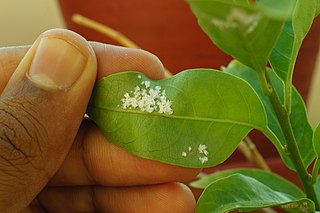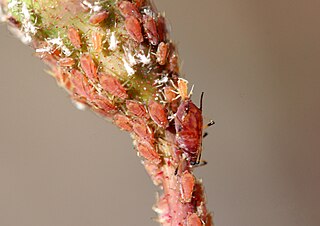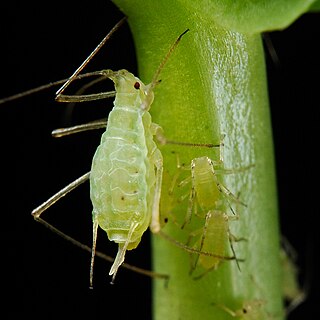
Aphids are small sap-sucking insects and members of the superfamily Aphidoidea. Common names include greenfly and blackfly, although individuals within a species can vary widely in color. The group includes the fluffy white woolly aphids. A typical life cycle involves flightless females giving live birth to female nymphs—who may also be already pregnant, an adaptation scientists call telescoping generations—without the involvement of males. Maturing rapidly, females breed profusely so that the number of these insects multiplies quickly. Winged females may develop later in the season, allowing the insects to colonize new plants. In temperate regions, a phase of sexual reproduction occurs in the autumn, with the insects often overwintering as eggs.

Hover flies, also called flower flies or syrphid flies, make up the insect family Syrphidae. As their common name suggests, they are often seen hovering or nectaring at flowers; the adults of many species feed mainly on nectar and pollen, while the larvae (maggots) eat a wide range of foods. In some species, the larvae are saprotrophs, eating decaying plant and animal matter in the soil or in ponds and streams. In other species, the larvae are insectivores and prey on aphids, thrips, and other plant-sucking insects.

Formica is a genus of ants of the family Formicidae, commonly known as wood ants, mound ants, thatching ants, and field ants. Formica is the type genus of the Formicidae, and of the subfamily Formicinae. The type species of genus Formica is the European red wood ant Formica rufa. Ants of this genus tend to be between 4 and 8 mm long. Ants belonging to the Formica genus possess a single knob or bump located between their thorax and abdomen. These ants primarily feed on honeydew, a sugary liquid produced by aphids. Interestingly, Formica ants appear to take on a shepherding role with smaller aphids, relocating them to different parts of plants to ensure a continuous food source for the aphids. By doing so, the ants can establish a relatively sustainable honeydew supply for both themselves and their colony.

Commonly known as hellebores, the Eurasian genus Helleborus consists of approximately 20 species of herbaceous or evergreen perennial flowering plants in the family Ranunculaceae, within which it gave its name to the tribe of Helleboreae. Despite names such as "winter rose", "Christmas rose" and "Lenten rose", hellebores are not closely related to the rose family (Rosaceae). Many hellebore species are poisonous.

Woolly aphids are sap-sucking insects that produce a filamentous waxy white covering which resembles cotton or wool. The adults are winged and move to new locations where they lay egg masses. The nymphs often form large cottony masses on twigs, for protection from predators.
Citrus tristeza virus (CTV) is a viral species of the genus Closterovirus that causes the most economically damaging disease to its namesake plant genus, Citrus. The disease has led to the death of millions of Citrus trees all over the world and has rendered millions of others useless for production. Farmers in Brazil and other South American countries gave it the name "tristeza", meaning sadness in Portuguese and Spanish, referring to the devastation produced by the disease in the 1930s. The virus is transmitted most efficiently by the brown citrus aphid.

Myzus persicae, known as the green peach aphid, greenfly, or the peach-potato aphid, is a small green aphid belonging to the order Hemiptera. It is the most significant aphid pest of peach trees, causing decreased growth, shrivelling of the leaves and the death of various tissues. It also acts as a vector for the transport of plant viruses such as cucumber mosaic virus (CMV), potato virus Y (PVY) and tobacco etch virus (TEV). Potato virus Y and potato leafroll virus can be passed to members of the nightshade/potato family (Solanaceae), and various mosaic viruses to many other food crops.

Harmonia testudinaria, commonly known as the tortoise-shelled ladybird, is a species of ladybird belonging to the family Coccinellidae. The tortoise shelled-ladybird occurs in Australia, New Guinea, Indonesia and Hawaii.

Macrosiphini is an aphid tribe in the subfamily Aphidinae.
The Oil Palm Aphid, also known as Schizaphis (Schizaphis) rotundiventris, is an aphid in the superfamily Aphidoidea in the order Hemiptera. It is a true bug and sucks sap from plants.
Cerataphis is a genus of witch hazel and palm aphids in the family Aphididae. There are about 10 described species in Cerataphis.
Hayhurstia is a genus of aphids in the family Aphididae. There is one described species in Hayhurstia, H. atriplicis.
Sarucallis is a genus of aphids in the family Aphididae. There is one described species in Sarucallis, S. kahawaluokalani.

Sitobion is a genus of aphids in the family Aphididae. There are more than 80 described species in Sitobion.
Pseneo is a genus of aphid wasps in the family Crabronidae. There are more than 20 described species in Pseneo.

Ceroplastes is a genus of wax scales in the family Coccidae. There are more than 130 described species in Ceroplastes.

Capitophorus is a genus of aphids in the family Aphididae. There are more than 30 described species in Capitophorus.

Acyrthosiphon is a genus of aphids belonging to the family Aphididae.

Anoecia is a genus of aphids typical of the subfamily Anoeciinae.

Chaitophorus is a genus of aphids first described by Carl Ludwig Koch in 1854. This genus includes roughly 90 to 110 species, and is found in North America, Europe, and Asia.













